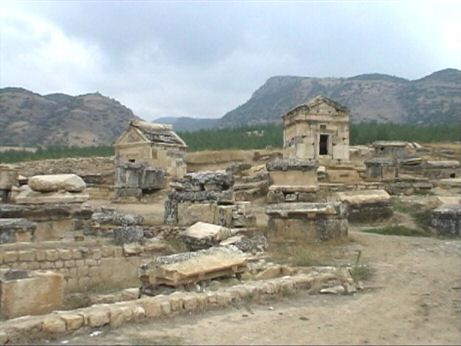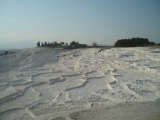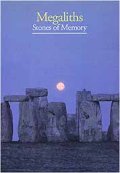<< Our Photo Pages >> Hierapolis - Ancient Village or Settlement in Turkey
Submitted by AlexHunger on Tuesday, 27 March 2007 Page Views: 6682
Multi-periodSite Name: HierapolisCountry: Turkey
NOTE: This site is 0.149 km away from the location you searched for.
Type: Ancient Village or Settlement
Nearest Town: Denizli Nearest Village: Pamukkale
Latitude: 37.924236N Longitude: 29.124440E
Condition:
| 5 | Perfect |
| 4 | Almost Perfect |
| 3 | Reasonable but with some damage |
| 2 | Ruined but still recognisable as an ancient site |
| 1 | Pretty much destroyed, possibly visible as crop marks |
| 0 | No data. |
| -1 | Completely destroyed |
| 5 | Superb |
| 4 | Good |
| 3 | Ordinary |
| 2 | Not Good |
| 1 | Awful |
| 0 | No data. |
| 5 | Can be driven to, probably with disabled access |
| 4 | Short walk on a footpath |
| 3 | Requiring a bit more of a walk |
| 2 | A long walk |
| 1 | In the middle of nowhere, a nightmare to find |
| 0 | No data. |
| 5 | co-ordinates taken by GPS or official recorded co-ordinates |
| 4 | co-ordinates scaled from a detailed map |
| 3 | co-ordinates scaled from a bad map |
| 2 | co-ordinates of the nearest village |
| 1 | co-ordinates of the nearest town |
| 0 | no data |
Internal Links:
External Links:
I have visited· I would like to visit
ModernExplorers visited on 7th Jun 2012 - their rating: Cond: 3 Amb: 3 Access: 3 Beautiful Roman structures next to the amazing Pamukkale
Tdiver visited on 1st Jan 1994 - their rating: Cond: 3 Amb: 5 Access: 5
h_fenton davidmorgan have visited here
Average ratings for this site from all visit loggers: Condition: 3 Ambience: 4 Access: 4
Ancient town built around hot springs for a spa in the 2nd Century BCE. The Greek name means "Holy City."
You may be viewing yesterday's version of this page. To see the most up to date information please register for a free account.















Do not use the above information on other web sites or publications without permission of the contributor.
Click here to see more info for this site
Nearby sites
Click here to view sites on an interactive map of the areaKey: Red: member's photo, Blue: 3rd party photo, Yellow: other image, Green: no photo - please go there and take one, Grey: site destroyed
Download sites to:
KML (Google Earth)
GPX (GPS waypoints)
CSV (Garmin/Navman)
CSV (Excel)
To unlock full downloads you need to sign up as a Contributory Member. Otherwise downloads are limited to 50 sites.
Turn off the page maps and other distractions
Nearby sites listing. In the following links * = Image available
1.7km N 349° Hierapolis Mausoleums* Rock Cut Tomb
9.9km S 188° Laodikeia* Ancient Village or Settlement
19.4km SE 142° Colossae* Ancient Village or Settlement
19.9km NW 310° Tripolis* Ancient Village or Settlement
33.8km SSW 193° Herakleia Hieron Ancient Temple
40.0km ENE 63° Eksi Hoyuk Ancient Village or Settlement
42.6km SW 236° Aphrodisias* Ancient Village or Settlement
62.6km NE 54° Beycesultan* Ancient Village or Settlement
70.2km NW 311° Gavurtepe Ancient Village or Settlement
82.6km SW 236° Hyllarima* Ancient Village or Settlement
85.9km W 269° Nysa* Ancient Village or Settlement
89.1km W 268° Acharaca Ancient Village or Settlement
90.9km SSE 159° Kibyra* Ancient Village or Settlement
91.2km SE 135° Camur Hoyuk Ancient Village or Settlement
92.5km ESE 114° Hacilar* Ancient Village or Settlement
97.1km ESE 109° Kurucay Hoyuk* Ancient Village or Settlement
104.6km ESE 102° Burdur Museum Museum
106.8km WSW 250° Alabanda* Ancient Village or Settlement
109.0km SSE 167° Boubon Ancient Village or Settlement
111.1km W 266° Aydin Archaeological Museum* Museum
113.2km WSW 238° Lagina Temple of Hecate* Ancient Temple
113.2km W 267° Tralleis Ancient Village or Settlement
113.7km WNW 303° Sardis Temple of Artemis* Ancient Temple
113.8km NW 304° Sardis* Ancient Village or Settlement
115.2km SSE 159° Balboura* Ancient Village or Settlement
View more nearby sites and additional images






 We would like to know more about this location. Please feel free to add a brief description and any relevant information in your own language.
We would like to know more about this location. Please feel free to add a brief description and any relevant information in your own language. Wir möchten mehr über diese Stätte erfahren. Bitte zögern Sie nicht, eine kurze Beschreibung und relevante Informationen in Deutsch hinzuzufügen.
Wir möchten mehr über diese Stätte erfahren. Bitte zögern Sie nicht, eine kurze Beschreibung und relevante Informationen in Deutsch hinzuzufügen. Nous aimerions en savoir encore un peu sur les lieux. S'il vous plaît n'hesitez pas à ajouter une courte description et tous les renseignements pertinents dans votre propre langue.
Nous aimerions en savoir encore un peu sur les lieux. S'il vous plaît n'hesitez pas à ajouter une courte description et tous les renseignements pertinents dans votre propre langue. Quisieramos informarnos un poco más de las lugares. No dude en añadir una breve descripción y otros datos relevantes en su propio idioma.
Quisieramos informarnos un poco más de las lugares. No dude en añadir una breve descripción y otros datos relevantes en su propio idioma.